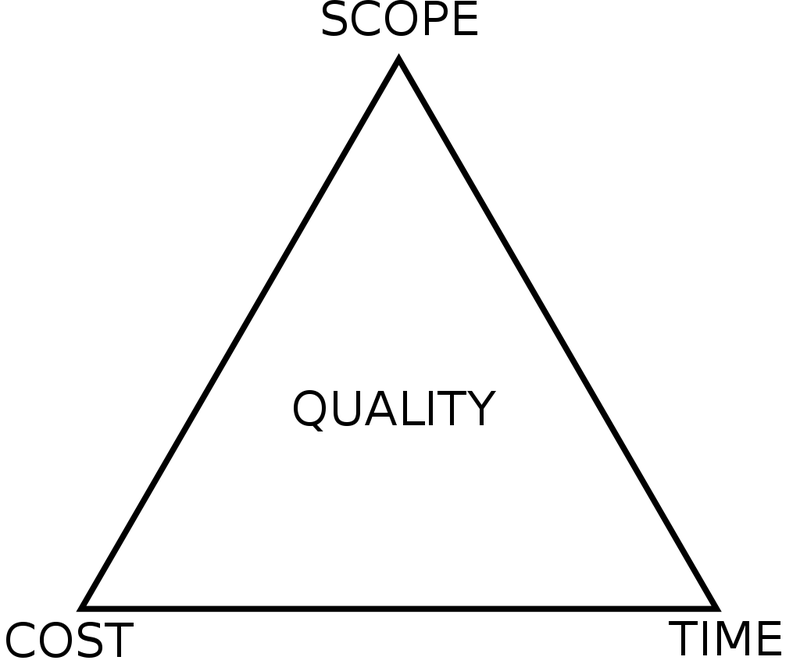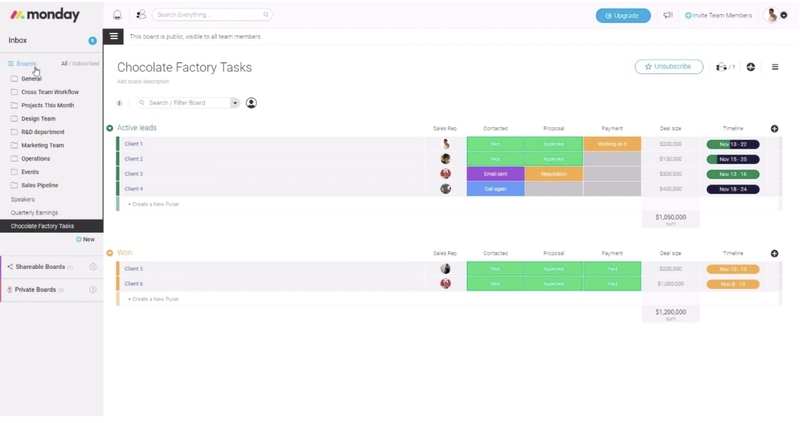

Image source: Getty Images
Every project manager is bound by the triple constraint. Learn how to tilt these three project factors in your favor.
Project management’s rule of the triple constraint is an inescapable reality. No organization has infinite resources and time, so if you’re assigned project manager responsibilities over a project, you must apply the triple constraint.
Also known as the iron triangle and project management triangle, the triple constraint is one of the project management basics and must be adhered to throughout the entire project life cycle.
Let’s look at how to make the triple constraint model work in your favor.
Overview: What is the triple constraint?
Every project is bound by three forces: time, cost, and scope. Collectively, they’re called the project management triple constraint.
You can’t change one without affecting the other two, and all three must be in balance. The outcome of any project depends on how well you balance these components.

This diagram illustrates the concept of the triple constraint. Image source: Author
The time constraint states a project schedule must meet specific deadlines. Cost relates to budgetary constraints. A project has to be delivered within certain cost parameters. And scope refers to the intended goal and deliverables of a project.
Here’s how it works. For every project, your organization must determine which of the three constraints has the highest priority, then align the other two to match.
For instance, if your project has a large scope, then the timelines and budget must support delivery of that scope. NASA took years to develop the technology to put a man on the moon. That goal was accomplished because deadlines and budgets were appropriately allocated to support the scope.
Sometimes, the cost or the deadline is the priority. Here, the scope must be adjusted to meet what’s possible in the time or budget allotted. That’s the trade-off inherent in every project, represented by the triple constraint model.
How to use the triple constraint theory
The triple constraint’s components are interdependent and must remain in balance. If the balance is tipped, a project will experience rising costs, missed deadlines, or uncontrolled scope. To avoid that, here’s how you apply the triple constraint to achieve a successful project.
Step 1: Alignment on the constraints
One of the first project management steps is to get a clear picture of the three constraints. Understand the implications of each, such as whether enough people are assigned to complete the work within the designated time frame.
Understanding this, the project manager can work with stakeholders to align the constraints and set expectations. Alignment is important if stakeholders are external parties being presented a project proposal or a statement of work.
A project manager must verify the allocated budget and timelines are reasonable based on the desired scope of the project. If not, a change must occur, and a project manager must get agreement from stakeholders on the required changes.
Tips for constraint alignment
Apply these tips to achieve alignment on the triple constraint parameters.
- Review organizational goals: When you’re evaluating whether a project’s timeline and budget make sense for its scope, consider how the project’s vision statement aligns with the company’s goals. If a project isn’t supporting a company goal, it’s likely to be underfunded or lack resources due to higher priorities. So during assessment, consider where the project lands among the organization’s objectives.
- Use the work breakdown structure: How can you be sure timelines and budgets make sense for a project? Use the work breakdown structure (WBS) to capture all the tasks related to a project. This will give you an accurate estimate of the time, cost, and people required to complete a project’s scope of work. If the WBS assessment results indicate the scope is not achievable within the time, cost requirements, or people assigned to the project, discuss options with stakeholders.
Step 2: Stakeholder involvement
To gain organizational alignment on a project’s scope, timelines, and budget, you must ensure stakeholders’ involvement. The degree of their involvement depends on how much a project affects the stakeholder and their part of the organization.
Typically, the larger or more complex the project, the more teams are affected and must be involved to varying degrees. The largest projects may require the CEO or other leaders in the company to be looped in.
If a project directly affects a team, not only must team decision-makers be involved, members of that department may need to participate in tasks related to project execution, such as testing a new workflow.
Tips for stakeholder involvement
It’s challenging to maintain stakeholder engagement throughout a project. These suggestions can help.
- Communicate regularly: If stakeholders aren’t up to date on a project’s progress, it can lead to misaligned expectations or the need to pause the project while change buy-ins are negotiated. To avoid this, provide regular stakeholder updates and meet frequently with the ones most directly involved in the project. This means a change to the triple constraint won’t catch a stakeholder off guard, causing delays.
- Offer solutions: If you must revisit the triple constraint parameters, a project manager should provide recommended solutions to stakeholders so the project manager doesn’t just drop a problem at their feet, but collaborates with them to find solutions.
Step 3: Managing to the constraints
Every project manager’s objective is to complete their project within the triple constraint parameters. To help with this, the project manager should review the work to be completed at the start of a project to clear up any scope ambiguities. This prevents scope creep.
Once a project is underway, the project manager must stay on top of team members to ensure they are on track to meet milestones. A project manager must also monitor costs to stay within budget.
Tips for managing to the constraints
There’s a lot involved in overseeing a project. These tips make managing the triple constraints a smooth process.
- Apply a buffer: Create a buffer during project planning for the time and cost elements of the triple constraint. This is important because many uncontrollable factors arise to prevent a project’s staying on track. For instance, a project may depend on external partners to provide key components, and delays on their part are not in a project manager’s control. This is where a buffer provides a cushion if the unforeseen occurs, and it will.
- Use tools: Leveraging project management tools is the best way to ensure you’re effectively managing a project’s resources, budgets, and timelines. Use project management software, such as monday.com, to streamline project manager work. It provides a timeline chart, resource management, budgeting features, and facilitates communication and collaboration for team management. It also allows you to plan for potential disruptions to the project schedule, such as vacations and holidays, so team productivity remains high throughout a project.

The board system in monday.com lets project managers track project status at a glance. Image source: Author
Step 4: Change management
A key project management technique is accounting for changes during project execution. One of the biggest reasons a project misses time and budget constraints is that its scope changes during the project.
Sometimes this is unavoidable due to shifts in company priorities. In other cases, the project manager needs to monitor situations where scope creep can occur. With a clear plan to manage project changes, the chances increase for successfully completing a project.
Your change management process should encompass the steps to introduce change to a project, how these changes are approved, and stakeholder sign-off on the revisions to timelines, budget, and scope. This formal change process should be determined at the start of a project with buy-in from stakeholders.
Tips for change management
These tips will help to incorporate a change management process for your project.
Examples of the triple constraint theory
It’s helpful to see how the triple constraint concept applies in different scenarios. These three common project situations illustrate how the triple constraint works in each.
1. Launching a new product
When a company rolls out a new product, the project involves a budget to develop and market the product, a deadline for the product’s launch date, and the list of features that must be part of the new product.
The timeline is usually the triple constraint component most flexible to change. That’s because a budget is assigned to ensure product profitability while the product’s features must be tantalizing enough to attract customers.
For example, when Tesla announces a new car model, it has a history of missing the timeline it originally stated for the car to ship. That’s because the vehicle’s scope of features must meet a specific set of criteria while also ensuring costs remain manageable to make a profit.
So if production delays cause the car to fall behind schedule, Tesla would rather miss its intended launch window than to sacrifice features or raise costs.
2. Deploying process changes
Implementing changes to a process, such as a new refund policy for customers, is another common scenario. Several tasks in the project plan must be completed to execute a process change successfully.
For example, customers have to be told of the change and internal teams must be trained on it. Therefore, with process changes, it’s usually impossible to reduce project scope to maintain the budget and time components of the triple constraint.
Scope creep is likely to happen as the project unfolds. That’s because it’s difficult from the outset to identify every organizational aspect affected by a process change, resulting in some pieces being missed from the initial project plan.
When these gaps are identified, it’s a matter of assessing if these pieces can wait for inclusion later, or whether there’s flexibility to increase budget or extend timelines to accommodate the additional work.
3. Implementing a marketing project
When a business executes a marketing project, cost is the company priority in the triple constraint model. Time is usually inflexible, resulting in scope being commonly sacrificed to support the other two constraints.
For example, when a company wants to make a big public announcement, it’s willing to spend more. If costs need to be lowered, it’s simply a matter of reducing marketing activities since many tactics exist to reach customers.
As for a marketing project’s timelines, these don’t change once set at the start of a project because marketing activities usually revolve around a date. For instance, a marketing campaign to promote a sales event over a holiday weekend can’t shift dates.
This makes it crucial to identify early during project execution if scope needs to quickly pare back to redeploy staff on those items that allow timelines to be met without increasing costs.
A last word about the triple constraint
It’s easy to view the triple constraint concept as a set of limitations, but it’s better to view them in a positive light. They act as a set of guides in a project proposal to mitigate risk and to deliver a successful project.
A positive perspective will reduce frustration and build momentum for achieving a project within the allotted budget, time, and scope.